One of the most common concerns that dog owners approach me with is regarding unusual skin conditions their pets develop. Among these, ringworm stands out due to its distinct appearance and the anxiety it often causes among pet parents. Recognizing the early signs of ringworm can make a significant difference in the speed and efficacy of treatment, not to mention the comfort of your beloved canine companion. In this article, I aim to provide a comprehensive visual guide on what ringworm looks like in dogs, accompanied by addressing this condition, ensuring your furry friend’s well-being. Let’s dive in.

What is Ringworm?
Ringworm, contrary to its name, is not caused by a worm. It’s a common misconception stemming from its circular appearance, which can resemble a worm curled into a ring. In reality, ringworm is a fungal infection caused by dermatophytes, a group of fungi that thrive on the skin’s outer layer, as well as on nails and hair.
Types of Dermatophytes:
There are several types of dermatophytes that can affect dogs, including:
- Microsporum canis: The most common cause of ringworm in dogs.
- Microsporum gypseum: Found in soil and can occasionally infect dogs.
- Trichophyton mentagrophytes: Less common, but can also be a culprit.
How Do Dogs Contract Ringworm?
Dogs can contract ringworm in various ways:
- Direct Contact: Dogs can get ringworm by coming into direct contact with another infected animal. This is the most common mode of transmission.
- Environment: The fungi can survive for a long time in the environment, especially in warm, humid conditions. Dogs can become infected when they touch contaminated objects such as bedding, grooming tools, or soil.
- Humans: While less common, dogs can also contract ringworm from infected humans and vice versa.
Symptoms of Ringworm in Dogs:
While we’ll delve deeper into the visual signs in the next section, common symptoms include:
- Circular patches of hair loss
- Reddened, scaly, or crusty skin
- Itchiness (though not all dogs will scratch or seem bothered)
- Brittle or distorted nails (in cases where the nails are infected)
It’s essential to understand that while ringworm is not a life-threatening condition, it is highly contagious. It can spread between animals and even to humans. Early detection and treatment are crucial to prevent its spread and ensure the health and comfort of your pet.

Early Signs of Ringworm in Dogs
Ringworm often begins subtly, making its early detection a bit challenging. However, being observant and recognizing the initial signs can make a significant difference in managing the condition. Here are the early signs to watch out for:
- Circular Patches of Hair Loss: One of the most telltale signs of ringworm is the appearance of small, circular patches where the hair has thinned or fallen out. These patches may gradually expand over time.
- Reddened and Scaly Skin: Within these bald patches, the skin often appears red and may have a slightly raised, scaly texture. The borders of these patches are typically more pronounced and may look inflamed.
- Mild Itchiness: While not all dogs will exhibit signs of discomfort, some may scratch, bite, or lick the affected areas due to mild itchiness. It’s worth noting that the degree of itchiness can vary from one dog to another.
- Dandruff-Like Flakes: Some dogs may show dandruff-like flakes on the affected areas. These flakes are a result of the skin’s reaction to the fungal infection.
- Brittle or Discolored Fur: Surrounding the affected area, the fur might appear brittle or have a dull, discolored appearance, indicating the fungus’s impact on the hair shafts.
- Initial Nail Changes (Less Common): In cases where the fungus affects the claws, the nails might become rough, brittle, or discolored. This sign is less common in the early stages but can be a clear indicator in advanced cases.
It’s crucial to remember that while these signs are indicative of ringworm, other skin conditions can exhibit similar symptoms. Early intervention not only aids in faster recovery but also helps in preventing the spread of the infection to other pets or even humans in the household.
Visual Guide: Ringworm on Dogs
Understanding what ringworm looks like can be the key to early detection and treatment. Here’s a visual breakdown of the progression and appearance of ringworm on dogs:
Early-stage Ringworm on a Dog’s Leg
A small, circular patch with slight hair loss. The center might appear slightly scaly with a reddish hue.
Description: At this stage, the lesion is often mistaken for a minor skin irritation. The defined circular shape is the key indicator.

Ringworm on a Dog’s Ear
Pronounced patchy hair loss, with the skin appearing redder and more inflamed. The hair loss is evident, and the border of the patch is distinct.
Description: The face, especially around the eyes and ears, is a common area for ringworm to appear. The skin might look dry and scaly.
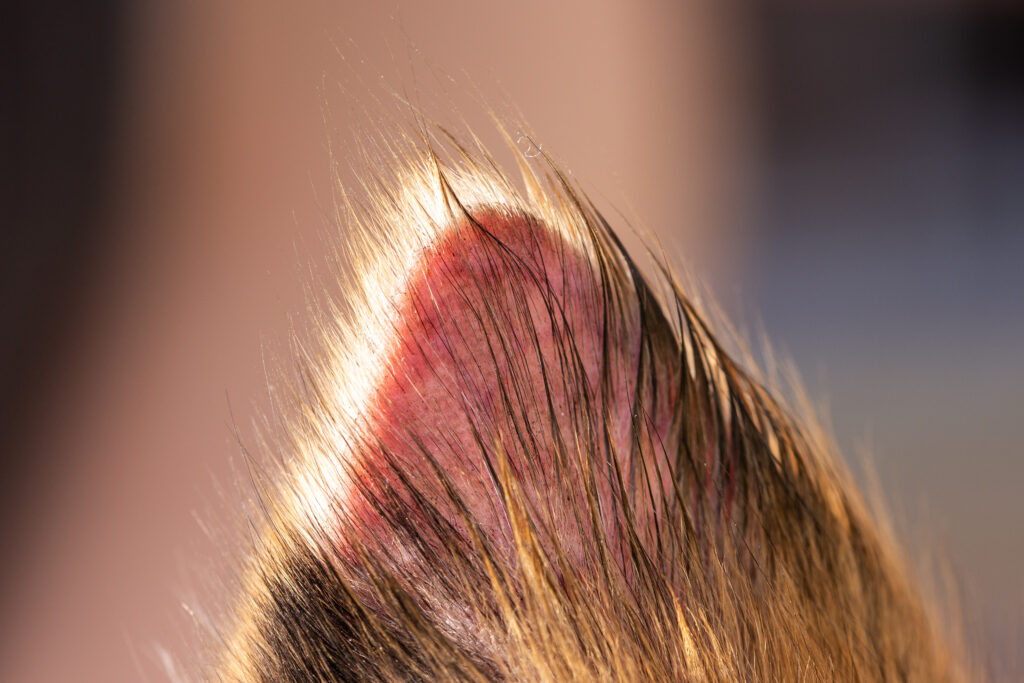
Advanced Ringworm on a Dog’s Back
A larger patch with significant hair loss. The skin might appear crusty with a mix of red and grayish tones.
Description: At this advanced stage, the lesion is more noticeable, and there might be multiple patches close to each other, sometimes merging.
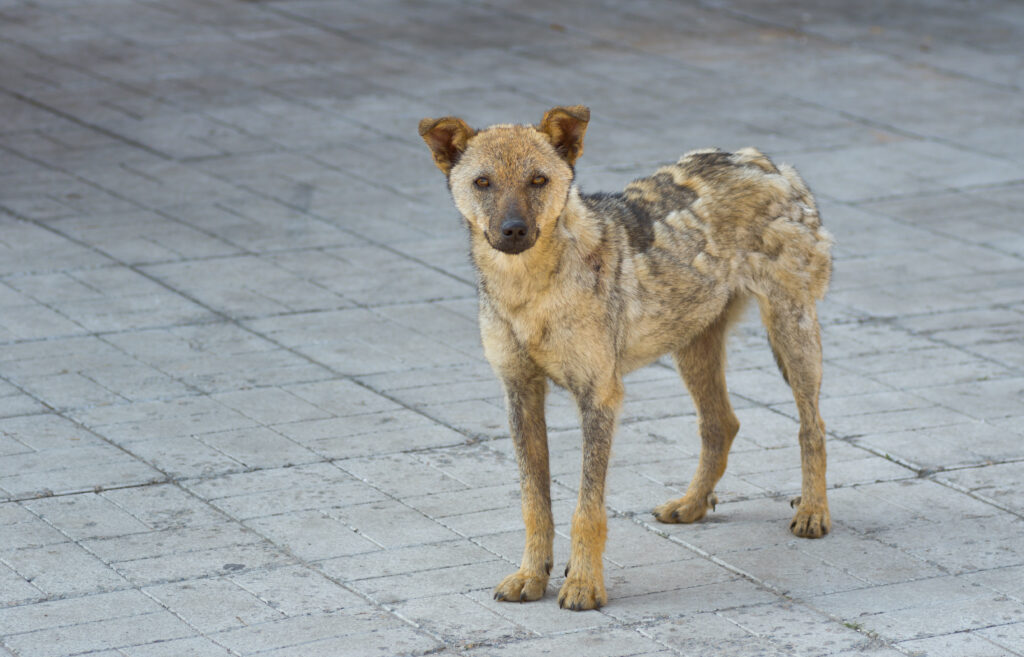
Ringworm on a Dog’s Paw
The skin between the toes showing redness and scaliness. There might be slight swelling.
Description: The paws can also be affected, especially if the dog has been walking on contaminated surfaces. The skin might appear cracked, and there could be discomfort when walking.
Ringworm Affecting the Nails
A close-up of a dog’s nail showing discoloration, roughness, and brittleness.
Description: Though less common, the nails can be affected, leading to discomfort and potential lameness if not addressed.
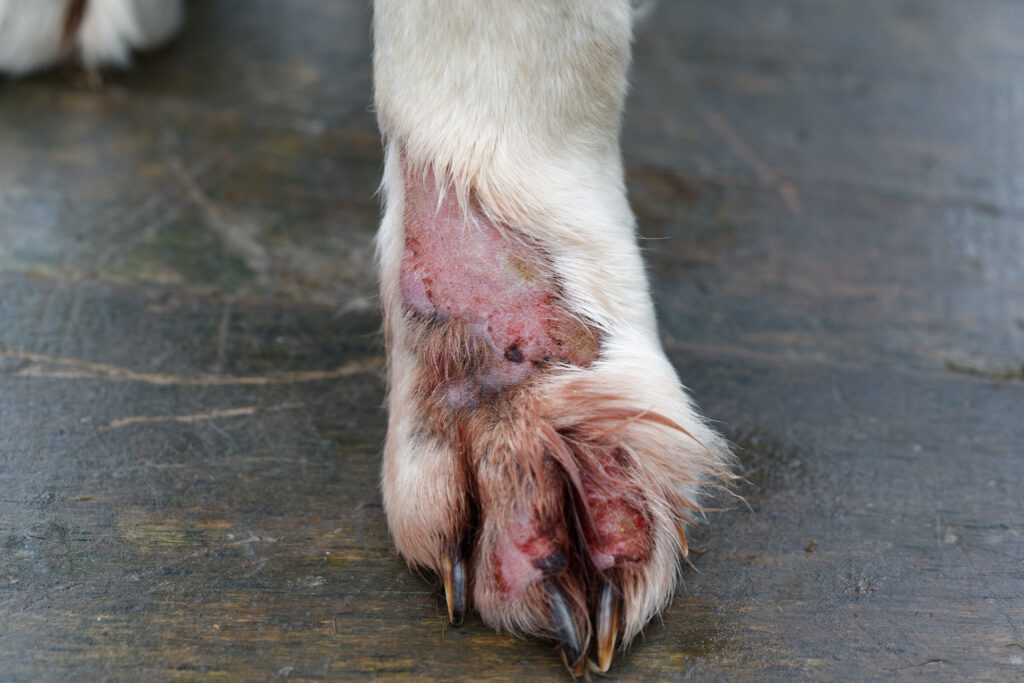
It’s essential to note that while these pictures and descriptions provide a clear guide, individual cases can vary. Factors like the dog’s skin color, fur type, and overall health can influence the appearance of ringworm. Always consult with a veterinarian if you suspect your dog has ringworm, as they can provide a definitive diagnosis and recommend the best course of treatment.
Comparing Ringworm to Other Skin Conditions
While ringworm has distinct characteristics, it’s not uncommon for it to be mistaken for other skin conditions that dogs might develop. Here’s a comparison to help differentiate ringworm from other common skin issues:
Ringworm vs. Flea Bites
Side-by-side images of a dog’s skin showing ringworm and flea bites.
Description:
- Ringworm: Circular, defined patches with hair loss, reddened and scaly skin.
- Flea Bites: Small, red, raised bumps often accompanied by intense itching. They might be scattered randomly and not have the defined circular shape of ringworm.
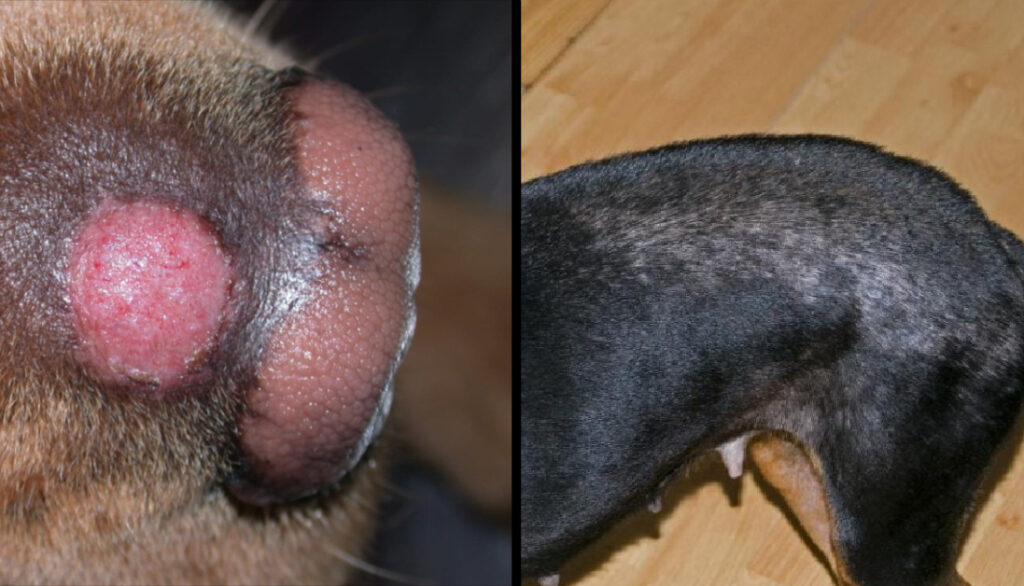
Ringworm vs. Demodex (Mange)
Side-by-side images of a dog’s skin showing ringworm and demodex.
Description:
- Ringworm: Circular patches with a clear border, hair loss, and possibly a scaly center.
- Demodex: Caused by the Demodex mite, this condition leads to hair loss, but without the defined circular pattern. The skin might appear thickened, red, and sometimes oily. In severe cases, pustules or crusts can form.
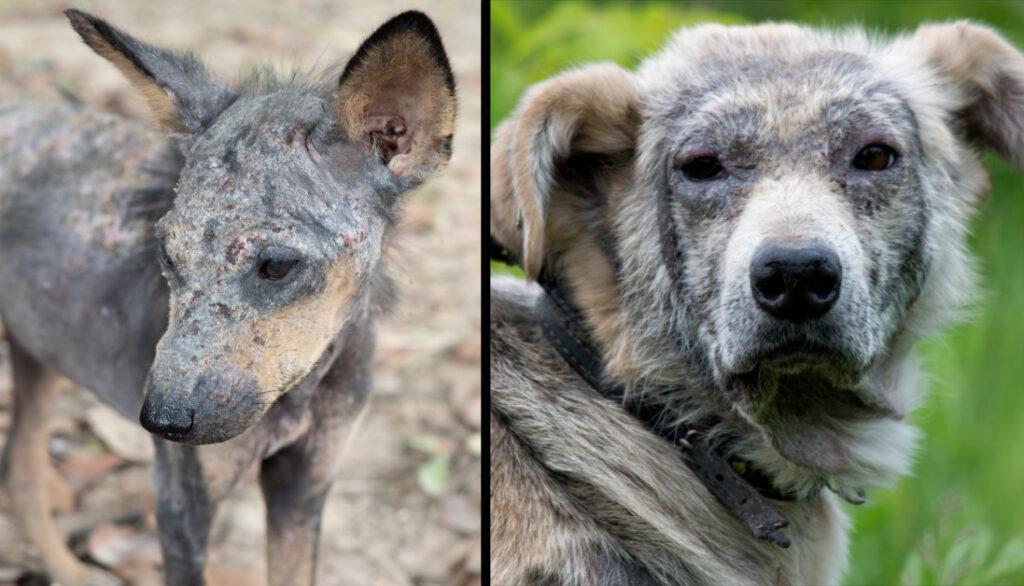
Ringworm vs. Allergic Reactions
Pic 8: Side-by-side images of a dog’s skin showing ringworm and allergic reactions.
Description:
- Ringworm: Defined circular patches with hair loss and a scaly or crusty appearance.
- Allergic Reactions: These can manifest as hives, redness, and swelling. The affected areas might be spread out and not have the circular shape characteristic of ringworm. The dog might also exhibit other symptoms like sneezing or watery eyes.
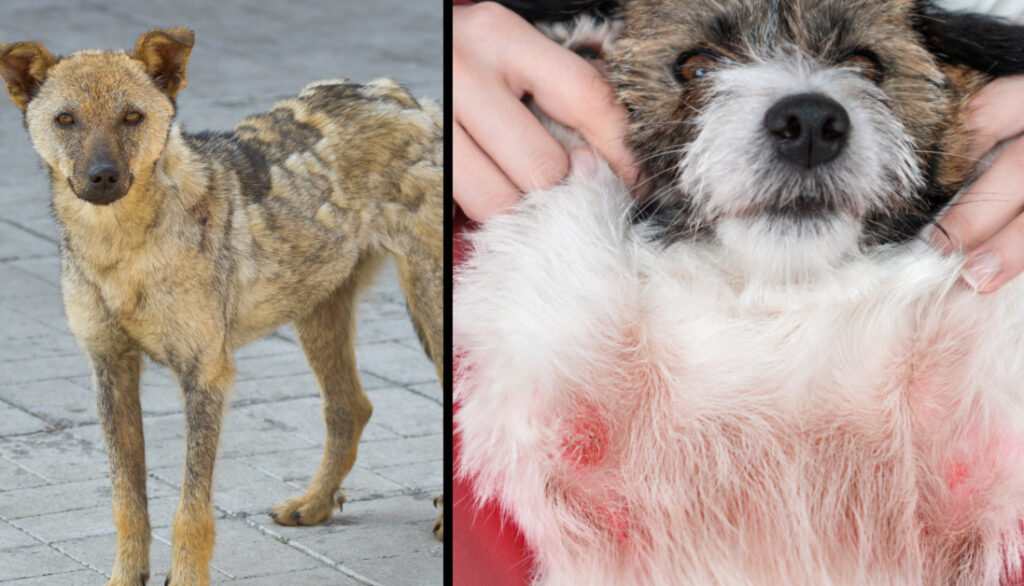
Recognizing the differences between ringworm and other skin conditions is crucial for effective treatment. While some symptoms might overlap, the visual distinctions, combined with other signs and the progression of the condition, can provide clarity. However, a definitive diagnosis should always be made by a veterinarian, as they can recommend the most appropriate treatment based on the specific condition.
Treatment and Prevention For Ringworm in Dogs
Ringworm, while uncomfortable and unsightly, is treatable. Addressing it promptly can prevent its spread and reduce the duration of the infection. Here’s a guide on the treatment and prevention of ringworm in dogs:
Treatment Options:
- Topical Antifungal Medications:
- Description: These are creams, ointments, or shampoos specifically formulated to treat fungal infections. They are applied directly to the affected areas.
- Examples: Miconazole, clotrimazole, and ketoconazole-based products.
- Oral Antifungal Medications:
- Description: For more severe or widespread infections, oral medications might be prescribed. These help treat the infection from the inside out.
- Examples: Griseofulvin, itraconazole, and terbinafine.
- Medicated Shampoos and Dips:
- Description: These are used to treat the entire coat, reducing the fungal load and preventing the spread to other areas of the body or other animals.
- Examples: Lime sulfur dips and ketoconazole shampoos.
- Environmental Cleaning:
- Description: It’s crucial to clean and disinfect the dog’s living environment to eliminate fungal spores. This includes bedding, toys, grooming tools, and other personal items.
- Recommendation: Use a bleach solution (1:10 ratio) or other pet-safe disinfectants.

Prevention Measures:
- Regular Grooming: Regularly grooming your dog can help in early detection of any skin abnormalities, including ringworm.
- Avoid Direct Contact: If you know an animal has ringworm, prevent your dog from coming into direct contact with it.
- Clean Environment: Regularly clean and disinfect your dog’s living spaces, especially if they’ve been diagnosed with ringworm.
- Wash Hands: After handling a dog with ringworm, always wash your hands thoroughly to prevent the spread of the fungus to other pets or humans.
- Isolation: If your dog is diagnosed with ringworm, it’s advisable to keep them isolated from other pets until the infection is fully treated.
- Regular Vet Check-ups: Regular visits to the veterinarian can help in early detection and treatment of various conditions, including ringworm.
While ringworm is a common condition in dogs, with timely intervention and the right care, it can be effectively treated. Always consult with your veterinarian for a definitive diagnosis and the best treatment plan tailored to your dog’s specific needs.
Conclusion
Ringworm in dogs, while a common concern, is a condition that can be effectively managed with timely detection and appropriate care. As pet owners, our furry companions rely on us to ensure their well-being. By educating ourselves about conditions like ringworm, we not only empower ourselves to act swiftly but also create a safer environment for our pets and those around them. Remember, while the visual guides and descriptions provided here are comprehensive, there’s no substitute for professional veterinary advice. Always consult with your veterinarian if you suspect any health issues in your dog. Together, we can ensure our pets lead healthy, happy lives, free from the discomfort of conditions like ringworm. Thank you for joining me on this informative journey, and I hope this guide serves you well in your pet parenting journey.
Frequently Asked Questions
Can humans get ringworm from dogs?
- A: Yes, ringworm is a zoonotic condition, meaning it can spread between animals and humans. If your dog has ringworm, it’s essential to follow preventive measures, such as washing hands after handling the dog and cleaning the environment, to reduce the risk of transmission.
How long does it take for ringworm to heal in dogs?
- A: With appropriate treatment, most cases of ringworm in dogs start to show improvement within 1-2 weeks. However, the entire course of treatment, which can last several weeks, should be completed to ensure the fungus is entirely eradicated.
Are certain dog breeds more susceptible to ringworm?
- A: While any dog can contract ringworm, puppies, elderly dogs, and those with compromised immune systems are more susceptible. Some breeds with specific genetic predispositions or skin conditions might also be more prone, but overall, all dogs are at risk.
Can my dog still interact with other pets while being treated for ringworm?
- A: It’s advisable to isolate a dog with ringworm from other pets during the initial stages of treatment to prevent the spread of the infection. Once the treatment is well underway and the veterinarian gives a go-ahead, interactions can gradually resume.
How can I prevent my dog from getting ringworm again in the future?
- A: Regular grooming, keeping your dog’s environment clean, and avoiding contact with infected animals are key preventive measures. Additionally, regular vet check-ups can help in early detection and management of any potential infections.
